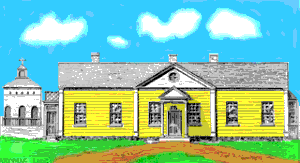
David William Smith, later Sir David, was the first Surveyor General of Upper Canada, and thus had a significant influence on the development of this province. It was he who laid out the basic plan for counties and townships and also for the Town of York.
He was born in Salisbury, England, in 1764. As a young man, he joined the Fifth Regiment and was, posted to Detroit. He was transferred to Newark in 1792 and from there to York, where he was given authority for surveying. His name appears on many early maps and surveys. He was elected a member of the House of Assembly in 1792, and was Speaker in 1797 and 1801. In 1798 he was appointed Lieutenant of the County of York. He and his family accumulated over 20,000 acres in 21 townships.

Maryvale Lodge (or Maryville)
He built “Maryvale Lodge” in the mid-1790s. It was a large wooden Georgian- style house painted bright yellow. Across the front was a large office, a spacious front hall, and a drawing room with a bay window on the end. Behind the office was a large parlour, a study, and bedchambers, with a separate wing to the back for the kitchen. Four more bedrooms and a housekeeper’s room were upstairs. The house was surrounded by an elaborate formal garden and many outbuildings. In 1802, Smith left Upper Canada for health reasons. Thomas Stoyell was the next occupent of Maryville Lodge. It later became a small private school. The house was demolished in 1854.
Smith’s description of Toronto in 1797 (then York) is most interesting:
“York, is in about 43 degrees and 35 minutes of north latitude, and is the present seat of Government of Upper Canada. It is most beautifully situated within an excellent harbour of the same name, made of a long peninsula, which confines a basin of water sufficiently large to contain a considerable fleet; on the extremity of the Peninsula, which is called Gibraltar Point, are commodious stores and block-houses, which command the entrance to the harbour.
“On the mainland, opposite to the Point, is the Garrison, situated in a fork made by the harbour and a small rivulet, which, being improved by sluices, affords an easy access for boats to go up to the stores; the barracks, being built on a knoll, are well situated for health, and command a delightful prospect of the lake to the west, and of the harbour to the east. The Government House is about two miles above the Garrison, near the head of the harbour, and the town is increasing rapidly; the River Don empties itself into the harbour a little above the town, running through a marsh, which when drained will afford most beautiful and fruitful meadows. This has already been commenced in a small degree, which will no doubt encourage further attempts.
“The long beach, or peninsula, which affords a most delightful ride, is considered so healthy by the Indians that they resort to it whenever indisposed; and so soon as the bridge over the Don is finished, it will, of course, be most generally resorted to, not only for pleasure, but as the most convenient road to the heights of Scarborough. The ground which has been prepared for the Government House is situated between the town and the River Don, on a most beautiful spot, the vicinity of which is well suited for gardens and a park. The oaks are in general large; the soil is excellent and well watered with creeks, one of which, by means of a short dam, may be thrown into all the streets of the town.
“Vessels of all sizes may be conveniently built here, and a kind of terrace or second bank in front of the town, affords an excellent situation for a rope- walk The remains of the old French fort, Toronto, stand a little to the westward of the present garrison, and the River Humber discharges into the Lake Ontario about two miles and a half west of that ; on this river and the Don are excellent mills, and all the waters abound in fish. In the winter the harbour is frozen, and affords excellent ice for the amusement of northern countries, driving en traineau. The climate of York is temperate and well sheltered from the northerly winds by the high lands in the rear. The Yonge Street leads from hence to Lake Simcoe, and the Dundas Street crosses the rear of the town.”
For more about Maryville Lodge and D.W. Smith see “A Glimpse of Toronto’s History” MPLS 237.
